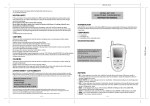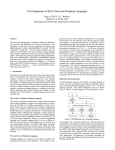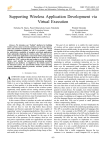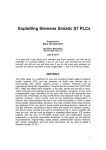Download Presentation Slides
Transcript
An Introduction to Python
Concurrency
David Beazley
http://www.dabeaz.com
Presented at USENIX Technical Conference
San Diego, June, 2009
Copyright (C) 2009, David Beazley, http://www.dabeaz.com
1
This Tutorial
• Python : An interpreted high-level programming
language that has a lot of support for "systems
programming" and which integrates well with
existing software in other languages.
• Concurrency : Doing more than one thing at a
time. Of particular interest to programmers
writing code for running on big iron, but also of
interest for users of multicore PCs. Usually a
bad idea--except when it's not.
Copyright (C) 2009, David Beazley, http://www.dabeaz.com
2
Support Files
• Code samples and support files for this class
http://www.dabeaz.com/usenix2009/concurrent/
• Please go there and follow along
Copyright (C) 2009, David Beazley, http://www.dabeaz.com
3
An Overview
• We're going to explore the state of concurrent
programming idioms being used in Python
• A look at tradeoffs and limitations
• Hopefully provide some clarity
• A tour of various parts of the standard library
• Goal is to go beyond the user manual and tie
everything together into a "bigger picture."
Copyright (C) 2009, David Beazley, http://www.dabeaz.com
4
Disclaimers
• The primary focus is on Python
• This is not a tutorial on how to write
concurrent programs or parallel algorithms
• No mathematical proofs involving "dining
philosophers" or anything like that
• I will assume that you have had some prior
exposure to topics such as threads, message
passing, network programming, etc.
Copyright (C) 2009, David Beazley, http://www.dabeaz.com
5
Disclaimers
• I like Python programming, but this tutorial is
not meant to be an advocacy talk
• In fact, we're going to be covering some
pretty ugly (e.g., "sucky") aspects of Python
• You might not even want to use Python by
the end of this presentation
• That's fine... education is my main agenda.
Copyright (C) 2009, David Beazley, http://www.dabeaz.com
6
Part I
Some Basic Concepts
Copyright (C) 2009, David Beazley, http://www.dabeaz.com
7
Concurrent Programming
• Creation of programs that can work on
more than one thing at a time
• Example : A network server that
communicates with several hundred clients
all connected at once
• Example : A big number crunching job that
spreads its work across multiple CPUs
Copyright (C) 2009, David Beazley, http://www.dabeaz.com
8
Multitasking
• Concurrency typically implies "multitasking"
Task A:
run
run
run
task switch
Task B:
run
run
• If only one CPU is available, the only way it
can run multiple tasks is by rapidly switching
between them
9
Copyright (C) 2009, David Beazley, http://www.dabeaz.com
Parallel Processing
• You may have parallelism (many CPUs)
• Here, you often get simultaneous task execution
Task A:
Task B:
run
run
run
run
run
run
CPU 1
CPU 2
• Note: If the total number of tasks exceeds the
number of CPUs, then each CPU also multitasks
Copyright (C) 2009, David Beazley, http://www.dabeaz.com
10
Task Execution
• All tasks execute by alternating between
CPU processing and I/O handling
run
run
run
run
I/O system call
• For I/O, tasks must wait (sleep)
• Behind the scenes, the underlying system will
carry out the I/O operation and wake the
task when it's finished
11
Copyright (C) 2009, David Beazley, http://www.dabeaz.com
CPU Bound Tasks
• A task is "CPU Bound" if it spends most of
its time processing with little I/O
I/O
run
I/O
run
run
• Examples:
• Crunching big matrices
• Image processing
Copyright (C) 2009, David Beazley, http://www.dabeaz.com
12
I/O Bound Tasks
• A task is "I/O Bound" if it spends most of its
time waiting for I/O
run
I/O
run
I/O
I/O
run
I/O
run
• Examples:
• Reading input from the user
• Networking
• File processing
• Most "normal" programs are I/O bound
Copyright (C) 2009, David Beazley, http://www.dabeaz.com
13
Shared Memory
• Tasks may run in the same memory space
Process
Task A:
run
run
run
CPU 1
read
object
write
Task B:
run
run
run
• Simultaneous access to objects
• Often a source of unspeakable peril
Copyright (C) 2009, David Beazley, http://www.dabeaz.com
CPU 2
14
Processes
• Tasks might run in separate processes
Task A:
Process
run
run
run
CPU 1
IPC
Process
Task B:
run
run
CPU 2
run
• Processes coordinate using IPC
• Pipes, FIFOs, memory mapped regions, etc.
Copyright (C) 2009, David Beazley, http://www.dabeaz.com
15
Distributed Computing
• Tasks may be running on distributed systems
Task A:
run
run
run
messages
Task B:
run
run
run
• For example, a cluster of workstations
• Communication via sockets
Copyright (C) 2009, David Beazley, http://www.dabeaz.com
16
Part 2
Why Concurrency and Python?
Copyright (C) 2009, David Beazley, http://www.dabeaz.com
17
Some Issues
• Python is interpreted
"What the hardware giveth, the software taketh away."
• Frankly, it doesn't seem like a natural match
for any sort of concurrent programming
• Isn't concurrent programming all about high
performance anyways???
Copyright (C) 2009, David Beazley, http://www.dabeaz.com
18
Why Use Python at All?
• Python is a very high level language
• And it comes with a large library
• Useful data types (dictionaries, lists,etc.)
• Network protocols
• Text parsing (regexs, XML, HTML, etc.)
• Files and the file system
• Databases
• Programmers like using this stuff...
Copyright (C) 2009, David Beazley, http://www.dabeaz.com
19
Python as a Framework
• Python is often used as a high-level framework
• The various components might be a mix of
languages (Python, C, C++, etc.)
• Concurrency may be a core part of the
framework's overall architecture
• Python has to deal with it even if a lot of the
underlying processing is going on in C
Copyright (C) 2009, David Beazley, http://www.dabeaz.com
20
Programmer Performance
• Programmers are often able to get complex
systems to "work" in much less time using a
high-level language like Python than if they're
spending all of their time hacking C code.
"The best performance improvement is the transition from
the nonworking to the working state."
- John Ousterhout
"Premature optimization is the root of all evil."
- Donald Knuth
"You can always optimize it later."
- Unknown
Copyright (C) 2009, David Beazley, http://www.dabeaz.com
21
Performance is Irrelevant
• Many concurrent programs are "I/O bound"
• They spend virtually all of their time sitting
around waiting
• Python can "wait" just as fast as C (maybe
even faster--although I haven't measured it).
• If there's not much processing, who cares if
it's being done in an interpreter? (One
exception : if you need an extremely rapid
response time as in real-time systems)
Copyright (C) 2009, David Beazley, http://www.dabeaz.com
22
You Can Go Faster
• Python can be extended with C code
• Look at ctypes, Cython, Swig, etc.
• If you need really high-performance, you're
not coding Python--you're using C extensions
• This is what most of the big scientific
computing hackers are doing
• It's called "using the right tool for the job"
Copyright (C) 2009, David Beazley, http://www.dabeaz.com
23
Commentary
• Concurrency is usually a really bad option if
you're merely trying to make an inefficient
Python script run faster
• Because its interpreted, you can often make
huge gains by focusing on better algorithms
or offloading work into C extensions
• For example, a C extension might make a
script run 20x faster vs. the marginal
improvement of parallelizing a slow script to
run on a couple of CPU cores
Copyright (C) 2009, David Beazley, http://www.dabeaz.com
24
Part 3
Python Thread Programming
Copyright (C) 2009, David Beazley, http://www.dabeaz.com
25
Concept: Threads
• What most programmers think of when they
hear about "concurrent programming"
• An independent task running inside a program
• Shares resources with the main program
(memory, files, network connections, etc.)
• Has its own independent flow of execution
(stack, current instruction, etc.)
Copyright (C) 2009, David Beazley, http://www.dabeaz.com
26
Thread Basics
% python program.py
Program launch. Python
loads a program and starts
executing statements
statement
statement
...
"main thread"
27
Copyright (C) 2009, David Beazley, http://www.dabeaz.com
Thread Basics
% python program.py
statement
statement
...
Creation of a thread.
Launches a function.
create thread(foo)
Copyright (C) 2009, David Beazley, http://www.dabeaz.com
def foo():
28
Thread Basics
% python program.py
statement
statement
...
create thread(foo)
statement
statement
...
def foo():
statement
statement
...
Concurrent
execution
of statements
29
Copyright (C) 2009, David Beazley, http://www.dabeaz.com
Thread Basics
% python program.py
statement
statement
...
create thread(foo)
statement
statement
...
statement
statement
...
Copyright (C) 2009, David Beazley, http://www.dabeaz.com
def foo():
thread terminates
on return or exit
statement
statement
...
return or exit
30
Thread Basics
% python program.py
statement
statement
...
create thread(foo)
statement
statement
...
statement
statement
...
Key idea: Thread is like a little
"task" that independently runs
inside your program
thread
def foo():
statement
statement
...
return or exit
Copyright (C) 2009, David Beazley, http://www.dabeaz.com
31
threading module
• Python threads are defined by a class
import time
import threading
class CountdownThread(threading.Thread):
def __init__(self,count):
threading.Thread.__init__(self)
self.count = count
def run(self):
while self.count > 0:
print "Counting down", self.count
self.count -= 1
time.sleep(5)
return
• You inherit from Thread and redefine run()
Copyright (C) 2009, David Beazley, http://www.dabeaz.com
32
threading module
• Python threads are defined by a class
import time
import threading
This code
executes in
the thread
class CountdownThread(threading.Thread):
def __init__(self,count):
threading.Thread.__init__(self)
self.count = count
def run(self):
while self.count > 0:
print "Counting down", self.count
self.count -= 1
time.sleep(5)
return
• You inherit from Thread and redefine run()
33
Copyright (C) 2009, David Beazley, http://www.dabeaz.com
threading module
• To launch, create thread objects and call start()
t1 = CountdownThread(10)
t1.start()
# Create the thread object
# Launch the thread
t2 = CountdownThread(20)
t2.start()
# Create another thread
# Launch
• Threads execute until the run() method stops
Copyright (C) 2009, David Beazley, http://www.dabeaz.com
34
Functions as threads
• Alternative method of launching threads
def countdown(count):
while count > 0:
print "Counting down", count
count -= 1
time.sleep(5)
t1 = threading.Thread(target=countdown,args=(10,))
t1.start()
• Creates a Thread object, but its run()
method just calls the given function
Copyright (C) 2009, David Beazley, http://www.dabeaz.com
35
Joining a Thread
• Once you start a thread, it runs independently
• Use t.join() to wait for a thread to exit
t.start()
# Launch a thread
...
# Do other work
...
# Wait for thread to finish
t.join()
# Waits for thread t to exit
• This only works from other threads
• A thread can't join itself
Copyright (C) 2009, David Beazley, http://www.dabeaz.com
36
Daemonic Threads
• If a thread runs forever, make it "daemonic"
t.daemon = True
t.setDaemon(True)
• If you don't do this, the interpreter will lock
when the main thread exits---waiting for the
thread to terminate (which never happens)
• Normally you use this for background tasks
37
Copyright (C) 2009, David Beazley, http://www.dabeaz.com
Interlude
• Creating threads is really easy
• You can create thousands of them if you want
• Programming with threads is hard
• Really hard
Q: Why did the multithreaded chicken cross the road?
A: to To other side. get the
-- Jason Whittington
Copyright (C) 2009, David Beazley, http://www.dabeaz.com
38
Access to Shared Data
• Threads share all of the data in your program
• Thread scheduling is non-deterministic
• Operations often take several steps and might
be interrupted mid-stream (non-atomic)
• Thus, access to any kind of shared data is also
non-deterministic (which is a really good way
to have your head explode)
39
Copyright (C) 2009, David Beazley, http://www.dabeaz.com
Accessing Shared Data
• Consider a shared object
x = 0
• And two threads that modify it
Thread-1
-------...
x = x + 1
...
Thread-2
-------...
x = x - 1
...
• It's possible that the resulting value will be
unpredictably corrupted
Copyright (C) 2009, David Beazley, http://www.dabeaz.com
40
Accessing Shared Data
• The two threads
Thread-1
-------...
x = x + 1
...
Thread-2
-------...
x = x - 1
...
• Low level interpreter execution
Thread-1
--------
LOAD_GLOBAL
LOAD_CONST
Thread-2
--------
1 (x)
2 (1)
thread
switch
BINARY_ADD
STORE_GLOBAL 1 (x)
LOAD_GLOBAL 1 (x)
LOAD_CONST
2 (1)
BINARY_SUB
STORE_GLOBAL 1 (x)
thread
switch
41
Copyright (C) 2009, David Beazley, http://www.dabeaz.com
Accessing Shared Data
• Low level interpreter code
Thread-1
--------
LOAD_GLOBAL
LOAD_CONST
Thread-2
--------
1 (x)
2 (1)
thread
switch
BINARY_ADD
STORE_GLOBAL 1 (x)
LOAD_GLOBAL 1 (x)
LOAD_CONST
2 (1)
BINARY_SUB
STORE_GLOBAL 1 (x)
thread
switch
These operations get performed with a "stale"
value of x. The computation in Thread-2 is lost.
Copyright (C) 2009, David Beazley, http://www.dabeaz.com
42
Accessing Shared Data
• Is this actually a real concern?
x = 0
# A shared value
def foo():
global x
for i in xrange(100000000): x += 1
def bar():
global x
for i in xrange(100000000): x -= 1
t1 = threading.Thread(target=foo)
t2 = threading.Thread(target=bar)
t1.start(); t2.start()
t1.join(); t2.join()
# Wait for completion
print x
# Expected result is 0
• Yes, the print produces a random nonsensical
value each time (e.g., -83412 or 1627732)
Copyright (C) 2009, David Beazley, http://www.dabeaz.com
43
Race Conditions
• The corruption of shared data due to
thread scheduling is often known as a "race
condition."
• It's often quite diabolical--a program may
produce slightly different results each time
it runs (even though you aren't using any
random numbers)
• Or it may just flake out mysteriously once
every two weeks
Copyright (C) 2009, David Beazley, http://www.dabeaz.com
44
Thread Synchronization
• Identifying and fixing a race condition will
make you a better programmer (e.g., it
"builds character")
• However, you'll probably never get that
month of your life back...
• To fix :You have to synchronize threads
45
Copyright (C) 2009, David Beazley, http://www.dabeaz.com
Part 4
Thread Synchronization Primitives
Copyright (C) 2009, David Beazley, http://www.dabeaz.com
46
Synchronization Options
• The threading library defines the following
objects for synchronizing threads
• Lock
• RLock
• Semaphore
• BoundedSemaphore
• Event
• Condition
Copyright (C) 2009, David Beazley, http://www.dabeaz.com
47
Synchronization Options
• In my experience, there is often a lot of
confusion concerning the intended use of
the various synchronization objects
• Maybe because this is where most
students "space out" in their operating
system course (well, yes actually)
• Anyways, let's take a little tour
Copyright (C) 2009, David Beazley, http://www.dabeaz.com
48
Mutex Locks
• Mutual Exclusion Lock
m = threading.Lock()
• Probably the most commonly used
synchronization primitive
• Primarily used to synchronize threads so
that only one thread can make modifications
to shared data at any given time
49
Copyright (C) 2009, David Beazley, http://www.dabeaz.com
Mutex Locks
• There are two basic operations
m.acquire()
m.release()
# Acquire the lock
# Release the lock
• Only one thread can successfully acquire the
lock at any given time
• If another thread tries to acquire the lock
when its already in use, it gets blocked until
the lock is released
Copyright (C) 2009, David Beazley, http://www.dabeaz.com
50
Use of Mutex Locks
• Commonly used to enclose critical sections
x = 0
x_lock = threading.Lock()
Critical
Section
Thread-1
-------...
x_lock.acquire()
Thread-2
-------...
x_lock.acquire()
x = x + 1
x = x - 1
x_lock.release()
...
x_lock.release()
...
• Only one thread can execute in critical section
at a time (lock gives exclusive access)
51
Copyright (C) 2009, David Beazley, http://www.dabeaz.com
Using a Mutex Lock
• It is your responsibility to identify and lock
all "critical sections"
x = 0
x_lock = threading.Lock()
Thread-1
-------...
x_lock.acquire()
x = x + 1
x_lock.release()
...
Copyright (C) 2009, David Beazley, http://www.dabeaz.com
Thread-2
-------...
x = x - 1
...
If you use a lock in one place, but
not another, then you're missing
the whole point. All modifications
to shared state must be enclosed
by lock acquire()/release().
52
Locking Perils
• Locking looks straightforward
• Until you start adding it to your code
• Managing locks is a lot harder than it looks
Copyright (C) 2009, David Beazley, http://www.dabeaz.com
53
Lock Management
• Acquired locks must always be released
• However, it gets evil with exceptions and
other non-linear forms of control-flow
• Always try to follow this prototype:
x = 0
x_lock = threading.Lock()
# Example critical section
x_lock.acquire()
try:
statements using x
finally:
x_lock.release()
Copyright (C) 2009, David Beazley, http://www.dabeaz.com
54
Lock Management
• Python 2.6/3.0 has an improved mechanism
for dealing with locks and critical sections
x = 0
x_lock = threading.Lock()
# Critical section
with x_lock:
statements using x
...
• This automatically acquires the lock and
releases it when control enters/exits the
associated block of statements
Copyright (C) 2009, David Beazley, http://www.dabeaz.com
55
Locks and Deadlock
• Don't write code that acquires more than
one mutex lock at a time
x = 0
y = 0
x_lock = threading.Lock()
y_lock = threading.Lock()
with x_lock:
statements using x
...
with y_lock:
statements using x and y
...
• This almost invariably ends up creating a
program that mysteriously deadlocks (even
more fun to debug than a race condition)
Copyright (C) 2009, David Beazley, http://www.dabeaz.com
56
RLock
• Reentrant Mutex Lock
m = threading.RLock()
m.acquire()
m.release()
# Create a lock
# Acquire the lock
# Release the lock
• Similar to a normal lock except that it can be
reacquired multiple times by the same thread
• However, each acquire() must have a release()
• Common use : Code-based locking (where
you're locking function/method execution as
opposed to data access)
Copyright (C) 2009, David Beazley, http://www.dabeaz.com
57
RLock Example
• Implementing a kind of "monitor" object
class Foo(object):
lock = threading.RLock()
def bar(self):
with Foo.lock:
...
def spam(self):
with Foo.lock:
...
self.bar()
...
• Only one thread is allowed to execute
methods in the class at any given time
• However, methods can call other methods that
are holding the lock (in the same thread)
Copyright (C) 2009, David Beazley, http://www.dabeaz.com
58
Semaphores
• A counter-based synchronization primitive
m = threading.Semaphore(n) # Create a semaphore
m.acquire()
# Acquire
m.release()
# Release
• acquire() - Waits if the count is 0, otherwise
decrements the count and continues
• release() - Increments the count and signals
waiting threads (if any)
• Unlike locks, acquire()/release() can be called
in any order and by any thread
Copyright (C) 2009, David Beazley, http://www.dabeaz.com
59
Semaphore Uses
• Resource control.
You can limit the number
of threads performing certain operations.
For example, performing database queries,
making network connections, etc.
• Signaling. Semaphores can be used to send
"signals" between threads. For example,
having one thread wake up another thread.
Copyright (C) 2009, David Beazley, http://www.dabeaz.com
60
Resource Control
• Using a semaphore to limit resources
sema = threading.Semaphore(5)
# Max: 5-threads
def fetch_page(url):
sema.acquire()
try:
u = urllib.urlopen(url)
return u.read()
finally:
sema.release()
• In this example, only 5 threads can be
executing the function at once (if there are
more, they will have to wait)
61
Copyright (C) 2009, David Beazley, http://www.dabeaz.com
Thread Signaling
• Using a semaphore to signal
done = threading.Semaphore(0)
Thread 1
...
statements
statements
statements
done.release()
Thread 2
done.acquire()
statements
statements
statements
...
• Here, acquire() and release() occur in different
threads and in a different order
• Often used with producer-consumer problems
Copyright (C) 2009, David Beazley, http://www.dabeaz.com
62
Events
• Event Objects
e = threading.Event()
e.isSet()
# Return True if event set
e.set()
# Set event
e.clear()
# Clear event
e.wait()
# Wait for event
• This can be used to have one or more
threads wait for something to occur
• Setting an event will unblock all waiting
threads simultaneously (if any)
• Common use : barriers, notification
63
Copyright (C) 2009, David Beazley, http://www.dabeaz.com
Event Example
• Using an event to ensure proper initialization
init = threading.Event()
def worker():
init.wait()
statements
...
def initialize():
statements
statements
...
init.set()
# Wait until initialized
# Setting up
# ...
# Done initializing
Thread(target=worker).start()
Thread(target=worker).start()
Thread(target=worker).start()
initialize()
Copyright (C) 2009, David Beazley, http://www.dabeaz.com
# Launch workers
# Initialize
64
Event Example
• Using an event to signal "completion"
def master():
...
item = create_item()
evt = Event()
worker.send((item,evt))
...
# Other processing
...
...
...
...
...
# Wait for worker
evt.wait()
Worker Thread
item, evt = get_work()
processing
processing
...
...
# Done
evt.set()
• Might use for asynchronous processing, etc.
Copyright (C) 2009, David Beazley, http://www.dabeaz.com
65
Condition Variables
• Condition Objects
cv = threading.Condition([lock])
cv.acquire()
# Acquire the underlying lock
cv.release()
# Release the underlying lock
cv.wait()
# Wait for condition
cv.notify()
# Signal that a condition holds
cv.notifyAll()
# Signal all threads waiting
• A combination of locking/signaling
• Lock is used to protect code that establishes
some sort of "condition" (e.g., data available)
• Signal is used to notify other threads that a
"condition" has changed state
Copyright (C) 2009, David Beazley, http://www.dabeaz.com
66
Condition Variables
• Common Use : Producer/Consumer patterns
items = []
items_cv = threading.Condition()
Producer Thread
Consumer Thread
item = produce_item()
with items_cv:
items.append(item)
with items_cv:
...
x = items.pop(0)
# Do something with x
...
• First, you use the locking part of a CV
synchronize access to shared data (items)
67
Copyright (C) 2009, David Beazley, http://www.dabeaz.com
Condition Variables
• Common Use : Producer/Consumer patterns
items = []
items_cv = threading.Condition()
Producer Thread
Consumer Thread
item = produce_item()
with items_cv:
items.append(item)
items_cv.notify()
with items_cv:
while not items:
items_cv.wait()
x = items.pop(0)
# Do something with x
...
• Next you add signaling and waiting
• Here, the producer signals the consumer
that it put data into the shared list
Copyright (C) 2009, David Beazley, http://www.dabeaz.com
68
Condition Variables
• Some tricky bits involving wait()
Consumer Thread
Before
waiting,
you
have
•
to acquire the lock
• wait() releases the lock
when waiting and
reacquires when woken
with items_cv:
while not items:
items_cv.wait()
x = items.pop(0)
# Do something with x
...
• Conditions are often transient and may not
hold by the time wait() returns. So, you must
always double-check (hence, the while loop)
69
Copyright (C) 2009, David Beazley, http://www.dabeaz.com
Interlude
• Working with all of the synchronization
primitives is a lot trickier than it looks
• There are a lot of nasty corner cases and
horrible things that can go wrong
• Bad performance, deadlock, livelock,
starvation, bizarre CPU scheduling, etc...
• All are valid reasons to not use threads
Copyright (C) 2009, David Beazley, http://www.dabeaz.com
70
Part 5
Threads and Queues
71
Copyright (C) 2009, David Beazley, http://www.dabeaz.com
Threads and Queues
• Threaded programs are often easier to manage
if they can be organized into producer/
consumer components connected by queues
Thread 1
(Producer)
send(item)
Queue
Thread 2
(Consumer)
• Instead of "sharing" data, threads only
coordinate by sending data to each other
• Think Unix "pipes" if you will...
Copyright (C) 2009, David Beazley, http://www.dabeaz.com
72
Queue Library Module
• Python has a thread-safe queuing module
• Basic operations
from Queue import Queue
q = Queue([maxsize])
q.put(item)
q.get()
q.empty()
q.full()
#
#
#
#
#
Create a queue
Put an item on the queue
Get an item from the queue
Check if empty
Check if full
• Usage :You try to strictly adhere to get/put
operations. If you do this, you don't need to
use other synchronization primitives.
73
Copyright (C) 2009, David Beazley, http://www.dabeaz.com
Queue Usage
• Most commonly used to set up various forms
of producer/consumer problems
from Queue import Queue
q = Queue()
Producer Thread
Consumer Thread
for item in produce_items():
q.put(item)
while True:
item = q.get()
consume_item(item)
• Critical point :You don't need locks here
Copyright (C) 2009, David Beazley, http://www.dabeaz.com
74
Queue Signaling
• Queues also have a signaling mechanism
q.task_done()
q.join()
# Signal that work is done
# Wait for all work to be done
• Many Python programmers don't know
about this (since it's relatively new)
• Used to determine when processing is done
Producer Thread
Consumer Thread
for item in produce_items():
q.put(item)
# Wait for consumer
q.join()
while True:
item = q.get()
consume_item(item)
q.task_done()
75
Copyright (C) 2009, David Beazley, http://www.dabeaz.com
Queue Programming
• There are many ways to use queues
• You can have as many consumers/producers
as you want hooked up to the same queue
producer
producer
producer
consumer
Queue
consumer
• In practice, try to keep it simple
Copyright (C) 2009, David Beazley, http://www.dabeaz.com
76
Part 6
The Problem with Threads
Copyright (C) 2009, David Beazley, http://www.dabeaz.com
77
An Inconvenient Truth
• Thread programming quickly gets hairy
• End up with a huge mess of shared data, locks,
queues, and other synchronization primitives
• Which is really unfortunate because Python
threads have some major limitations
• Namely, they have pathological performance!
Copyright (C) 2009, David Beazley, http://www.dabeaz.com
78
A Performance Test
• Consider this CPU-bound function
def count(n):
while n > 0:
n -= 1
• Sequential Execution:
count(100000000)
count(100000000)
• Threaded execution
t1 = Thread(target=count,args=(100000000,))
t1.start()
t2 = Thread(target=count,args=(100000000,))
t2.start()
• Now, you might expect two threads to run
twice as fast on multiple CPU cores
79
Copyright (C) 2009, David Beazley, http://www.dabeaz.com
Bizarre Results
• Performance comparison (Dual-Core 2Ghz
Macbook, OS-X 10.5.6)
Sequential
Threaded
: 24.6s
: 45.5s (1.8X slower!)
• If you disable one of the CPU cores...
Threaded
: 38.0s
• Insanely horrible performance.
Better
performance with fewer CPU cores? It
makes no sense.
Copyright (C) 2009, David Beazley, http://www.dabeaz.com
80
Interlude
• It's at this point that programmers often
decide to abandon threads altogether
• Or write a blog rant that vaguely describes
how Python threads "suck" because of their
failed attempt at Python supercomputing
• Well, yes there is definitely some "suck"
going on, but let's dig a little deeper...
81
Copyright (C) 2009, David Beazley, http://www.dabeaz.com
Part 7
The Inside Story on Python Threads
"The horror! The horror!" - Col. Kurtz
Copyright (C) 2009, David Beazley, http://www.dabeaz.com
82
What is a Thread?
• Python threads are real system threads
• POSIX threads (pthreads)
• Windows threads
• Fully managed by the host operating system
• All scheduling/thread switching
• Represent threaded execution of the Python
interpreter process (written in C)
Copyright (C) 2009, David Beazley, http://www.dabeaz.com
83
The Infamous GIL
• Here's the rub...
• Only one Python thread can execute in the
interpreter at once
• There is a "global interpreter lock" that
carefully controls thread execution
• The GIL ensures that sure each thread gets
exclusive access to the entire interpreter
internals when it's running
Copyright (C) 2009, David Beazley, http://www.dabeaz.com
84
GIL Behavior
• Whenever a thread runs, it holds the GIL
• However, the GIL is released on blocking I/O
run
I/O
run
I/O
e
ire ease uir ease
u
l
q
l
q
ac re
ac re
run
run
I/O
ire
e e
uir leas
q
ac re
u
cq
a
• So, any time a thread is forced to wait, other
"ready" threads get their chance to run
• Basically a kind of "cooperative" multitasking
85
Copyright (C) 2009, David Beazley, http://www.dabeaz.com
CPU Bound Processing
• To deal with CPU-bound threads, the
interpreter periodically performs a "check"
• By default, every 100 interpreter "ticks"
k
ec
ch
CPU Bound
Thread
Run 100
ticks
Copyright (C) 2009, David Beazley, http://www.dabeaz.com
Run 100
ticks
k
ec
ch
k
ec
ch
Run 100
ticks
86
The Check Interval
• The check interval is a global counter that is
completely independent of thread scheduling
100 ticks
k
ec
ch 100 ticks
k
ec
ch 100 ticks
k
ec
ch 100 ticks
Main Thread
Thread 2
Thread 3
Thread 4
• A "check" is simply made every 100 "ticks"
Copyright (C) 2009, David Beazley, http://www.dabeaz.com
87
The Periodic Check
• What happens during the periodic check?
• In the main thread only, signal handlers
will execute if there are any pending
signals
• Release and reacquisition of the GIL
• That last bullet describes how multiple CPU-
bound threads get to run (by briefly releasing
the GIL, other threads get a chance to run).
Copyright (C) 2009, David Beazley, http://www.dabeaz.com
88
What is a "Tick?"
• Ticks loosely map to interpreter instructions
def countdown(n):
while n > 0:
print n
n -= 1
• Instructions in
Tick 1
the Python VM
Tick 2
Tick 3
Tick 4
>>> import dis
>>> dis.dis(countdown)
0 SETUP_LOOP
3 LOAD_FAST
6 LOAD_CONST
9 COMPARE_OP
12 JUMP_IF_FALSE
15 POP_TOP
16 LOAD_FAST
19 PRINT_ITEM
20 PRINT_NEWLINE
21 LOAD_FAST
24 LOAD_CONST
27 INPLACE_SUBTRACT
28 STORE_FAST
31 JUMP_ABSOLUTE
...
33 (to 36)
0 (n)
1 (0)
4 (>)
19 (to 34)
0 (n)
0 (n)
2 (1)
0 (n)
3
89
Copyright (C) 2009, David Beazley, http://www.dabeaz.com
Tick Execution
• Interpreter ticks are not time-based
• Ticks don't have consistent execution times
• Long operations can block everything
>>> nums = xrange(100000000)
>>> -1 in nums
False
>>>
1 tick (~ 6.6 seconds)
• Try hitting Ctrl-C (ticks are uninterruptible)
>>> nums = xrange(100000000)
>>> -1 in nums
^C^C^C
(nothing happens, long pause)
...
KeyboardInterrupt
>>>
Copyright (C) 2009, David Beazley, http://www.dabeaz.com
90
Thread Scheduling
• Python does not have a thread scheduler
• There is no notion of thread priorities,
preemption, round-robin scheduling, etc.
• For example, the list of threads in the
interpreter isn't used for anything related to
thread execution
• All thread scheduling is left to the host
operating system (e.g., Linux, Windows, etc.)
Copyright (C) 2009, David Beazley, http://www.dabeaz.com
91
GIL Implementation
• The GIL is not a simple mutex lock
• The implementation (Unix) is either...
• A POSIX unnamed semaphore
• Or a pthreads condition variable
• All interpreter locking is based on signaling
• To acquire the GIL, check if it's free. If
not, go to sleep and wait for a signal
• To release the GIL, free it and signal
Copyright (C) 2009, David Beazley, http://www.dabeaz.com
92
Thread Scheduling
• Thread switching is far more subtle than most
programmers realize (it's tied up in the OS)
Thread 1
k
ec
100 ticks
ch
100 ticks
signal
signal
Operating
System
k
ec
ch
k
ec
ch
...
SUSPENDED
Thread
Context
Switch
signal
signal
Thread 2
SUSPENDED
k
ec
ch
signal
k
ec
ch
• The lag between signaling and scheduling may
be significant (depends on the OS)
Copyright (C) 2009, David Beazley, http://www.dabeaz.com
93
CPU-Bound Threads
• As we saw earlier, CPU-bound threads have
horrible performance properties
• Far worse than simple sequential execution
• 24.6 seconds (sequential)
• 45.5 seconds (2 threads)
• A big question : Why?
• What is the source of that overhead?
Copyright (C) 2009, David Beazley, http://www.dabeaz.com
94
Signaling Overhead
• GIL thread signaling is the source of that
• After every 100 ticks, the interpreter
• Locks a mutex
• Signals on a condition variable/semaphore
where another thread is always waiting
• Because another thread is waiting, extra
pthreads processing and system calls get
triggered to deliver the signal
Copyright (C) 2009, David Beazley, http://www.dabeaz.com
95
A Rough Measurement
• Sequential Execution (OS-X, 1 CPU)
• 736 Unix system calls
• 117 Mach System Calls
• Two threads (OS-X, 1 CPU)
• 1149 Unix system calls
• ~ 3.3 Million Mach System Calls
• Yow! Look at that last figure.
Copyright (C) 2009, David Beazley, http://www.dabeaz.com
96
Multiple CPU Cores
• The penalty gets far worse on multiple cores
• Two threads (OS-X, 1 CPU)
• 1149 Unix system calls
• ~3.3 Million Mach System Calls
• Two threads (OS-X, 2 CPUs)
• 1149 Unix system calls
• ~9.5 Million Mach System calls
97
Copyright (C) 2009, David Beazley, http://www.dabeaz.com
Multicore GIL Contention
• With multiple cores, CPU-bound threads get
scheduled simultaneously (on different
processors) and then have a GIL battle
Thread 1 (CPU 1)
Thread 2 (CPU 2)
run
Release GIL
Acquire GIL
signal
Wake
Acquire GIL (fails)
run
Release GIL
Acquire GIL
signal
run
Wake
Acquire GIL (fails)
• The waiting thread (T2) may make 100s of
failed GIL acquisitions before any success
Copyright (C) 2009, David Beazley, http://www.dabeaz.com
98
The GIL and C Code
• As mentioned, Python can talk to C/C++
• C/C++ extensions can release the
interpreter lock and run independently
• Caveat : Once released, C code shouldn't
do any processing related to the Python
interpreter or Python objects
• The C code itself must be thread-safe
99
Copyright (C) 2009, David Beazley, http://www.dabeaz.com
The GIL and C Extensions
• Having C extensions release the GIL is how
you get into true "parallel computing"
e
uir
ase
ele
Lr
Thread 1:
L
GI
Python
instructions
C extension
code
Python
instructions
Python
instructions
Thread 2
GI
ire
qu
c
La
Copyright (C) 2009, David Beazley, http://www.dabeaz.com
GI
q
ac
ase
ele
Lr
GI
100
How to Release the GIL
• The ctypes module already releases the GIL
when calling out to C code
• In hand-written C extensions, you have to
insert some special macros
PyObject *pyfunc(PyObject *self, PyObject *args) {
...
Py_BEGIN_ALLOW_THREADS
// Threaded C code
...
Py_END_ALLOW_THREADS
...
}
Copyright (C) 2009, David Beazley, http://www.dabeaz.com
101
The GIL and C Extensions
• The trouble with C extensions is that you
have to make sure they do enough work
• A dumb example (mindless spinning)
void churn(int n) {
while (n > 0) {
n--;
}
}
• How big do you have to make n to actually see
any kind of speedup on multiple cores?
Copyright (C) 2009, David Beazley, http://www.dabeaz.com
102
The GIL and C Extensions
• Here's some Python test code
def churner(n):
count = 1000000
while count > 0:
churn(n)
count -= 1
# C extension function
# Sequential execution
churner(n)
churner(n)
# Threaded execution
t1 = threading.Thread(target=churner, args=(n,))
t2 = threading.Thread(target=churner, args=(n,))
t1.start()
t2.start()
103
Copyright (C) 2009, David Beazley, http://www.dabeaz.com
The GIL and C Extensions
• Speedup of running two threads versus
sequential execution
2.0
1.5
Speedup 1.0
Extension code
runs for ~4
microseconds
per call
0.5
0
0
2,500
5,000
7,500 10,000
(n)
• Note: 2 Ghz Intel Core Duo, OS-X 10.5.6
Copyright (C) 2009, David Beazley, http://www.dabeaz.com
104
Why is the GIL there?
• Simplifies the implementation of the Python
interpreter (okay, sort of a lame excuse)
• Better suited for reference counting
(Python's memory management scheme)
• Simplifies the use of C/C++ extensions.
Extension functions do not need to worry
about thread synchronization
• And for now, it's here to stay... (although
people continue to try and eliminate it)
105
Copyright (C) 2009, David Beazley, http://www.dabeaz.com
Part 8
Final Words on Threads
Copyright (C) 2009, David Beazley, http://www.dabeaz.com
106
Using Threads
• Despite some "issues," there are situations
where threads are appropriate and where
they perform well
• There are also some tuning parameters
Copyright (C) 2009, David Beazley, http://www.dabeaz.com
107
I/O Bound Processing
• Threads are still useful for I/O-bound apps
• For example : A network server that needs to
maintain several thousand long-lived TCP
connections, but is not doing tons of heavy
CPU processing
• Here, you're really only limited by the host
operating system's ability to manage and
schedule a lot of threads
• Most systems don't have much of a problem-even with thousands of threads
Copyright (C) 2009, David Beazley, http://www.dabeaz.com
108
Why Threads?
• If everything is I/O-bound, you will get a very
quick response time to any I/O activity
• Python isn't doing the scheduling
• So, Python is going to have a similar response
behavior as a C program with a lot of I/O
bound threads
• Caveat: You have to stay I/O bound!
Copyright (C) 2009, David Beazley, http://www.dabeaz.com
109
Final Comments
• Python threads are a useful tool, but you
have to know how and when to use them
• I/O bound processing only
• Limit CPU-bound processing to C
extensions (that release the GIL)
• Threads are not the only way...
Copyright (C) 2009, David Beazley, http://www.dabeaz.com
110
Part 9
Processes and Messages
Copyright (C) 2009, David Beazley, http://www.dabeaz.com
111
Concept: Message Passing
• An alternative to threads is to run multiple
independent copies of the Python interpreter
• In separate processes
• Possibly on different machines
• Get the different interpreters to cooperate
by having them send messages to each other
Copyright (C) 2009, David Beazley, http://www.dabeaz.com
112
Message Passing
Python
send()
recv()
pipe/socket
Python
• On the surface, it's simple
• Each instance of Python is independent
• Programs just send and receive messages
• Two main issues
• What is a message?
• What is the transport mechanism?
113
Copyright (C) 2009, David Beazley, http://www.dabeaz.com
Messages
• A message is just a bunch of bytes (a buffer)
• A "serialized" representation of some data
• Creating serialized data in Python is easy
Copyright (C) 2009, David Beazley, http://www.dabeaz.com
114
pickle Module
• A module for serializing objects
• Serializing an object onto a "file"
import pickle
...
pickle.dump(someobj,f)
• Unserializing an object from a file
someobj = pickle.load(f)
• Here, a file might be a file, a pipe, a wrapper
around a socket, etc.
Copyright (C) 2009, David Beazley, http://www.dabeaz.com
115
pickle Module
• Pickle can also turn objects into byte strings
import pickle
# Convert to a string
s = pickle.dumps(someobj)
...
# Load from a string
someobj = pickle.loads(s)
• You might use this embed a Python object
into a message payload
Copyright (C) 2009, David Beazley, http://www.dabeaz.com
116
cPickle vs pickle
• There is an alternative implementation of
pickle called cPickle (written in C)
• Use it whenever possible--it is much faster
import cPickle as pickle
...
pickle.dump(someobj,f)
• There is some history involved. There are a
few things that cPickle can't do, but they are
somewhat obscure (so don't worry about it)
Copyright (C) 2009, David Beazley, http://www.dabeaz.com
117
Pickle Commentary
• Using pickle is almost too easy
• Almost any Python object works
• Builtins (lists, dicts, tuples, etc.)
• Instances of user-defined classes
• Recursive data structures
• Exceptions
• Files and network connections
• Running generators, etc.
Copyright (C) 2009, David Beazley, http://www.dabeaz.com
118
Message Transport
• Python has various low-level mechanisms
• Pipes
• Sockets
• FIFOs
• Libraries provide access to other systems
• MPI
• XML-RPC (and many others)
119
Copyright (C) 2009, David Beazley, http://www.dabeaz.com
An Example
• Launching a subprocess and hooking up the
child process via a pipe
• Use the subprocess module
import subprocess
p = subprocess.Popen(['python','child.py'],
stdin=subprocess.PIPE,
stdout=subprocess.PIPE)
p.stdin.write(data)
p.stdout.read(size)
# Send data to subprocess
# Read data from subprocess
Python
Python
p.stdin
p.stdout
Copyright (C) 2009, David Beazley, http://www.dabeaz.com
Pipe
sys.stdin
sys.stdout
120
Pipes and Pickle
• Most programmers would use the subprocess
module to run separate programs and collect
their output (e.g., system commands)
• However, if you put a pickling layer around the
files, it becomes much more interesting
• Becomes a communication channel where you
can send just about any Python object
Copyright (C) 2009, David Beazley, http://www.dabeaz.com
121
A Message Channel
• A class that wraps a pair of files
# channel.py
import pickle
class Channel(object):
def __init__(self,out_f,in_f):
self.out_f = out_f
self.in_f = in_f
def send(self,item):
pickle.dump(item,self.out_f)
self.out_f.flush()
def recv(self):
return pickle.load(self.in_f)
• Send/Receive implemented using pickle
Copyright (C) 2009, David Beazley, http://www.dabeaz.com
122
Some Sample Code
• A sample child process
# child.py
import channel
import sys
ch = channel.Channel(sys.stdout,sys.stdin)
while True:
item = ch.recv()
ch.send(("child",item))
• Parent process setup
# parent.py
import channel
import subprocess
p = subprocess.Popen(['python','child.py'],
stdin=subprocess.PIPE,
stdout=subprocess.PIPE)
ch = channel.Channel(p.stdin,p.stdout)
Copyright (C) 2009, David Beazley, http://www.dabeaz.com
123
Some Sample Code
• Using the child worker
>>> ch.send("Hello World")
Hello World
This output is being
>>> ch.send(42)
produced
by the child
42
>>> ch.send([1,2,3,4])
[1, 2, 3, 4]
>>> ch.send({'host':'python.org','port':80})
{'host': 'python.org', 'port': 80}
>>>
• You can send almost any Python object
(numbers, lists, dictionaries, instances, etc.)
Copyright (C) 2009, David Beazley, http://www.dabeaz.com
124
Big Picture
• Can easily have 10s-1000s of communicating
Python interpreters
Python
Python
Python
Python
Python
Python
Python
125
Copyright (C) 2009, David Beazley, http://www.dabeaz.com
Interlude
• Message passing is a fairly general concept
• However, it's also kind of nebulous in Python
• No agreed upon programming interface
• Vast number of implementation options
• Intersects with distributed objects, RPC,
cross-language messaging, etc.
Copyright (C) 2009, David Beazley, http://www.dabeaz.com
126
Part 10
The Multiprocessing Module
Copyright (C) 2009, David Beazley, http://www.dabeaz.com
127
multiprocessing Module
• A new library module added in Python 2.6
• Originally known as pyprocessing (a thirdparty extension module)
• This is a module for writing concurrent
Python programs based on communicating
processes
• A module that is especially useful for
concurrent CPU-bound processing
Copyright (C) 2009, David Beazley, http://www.dabeaz.com
128
Using multiprocessing
• Here's the cool part...
• You already know how to use multiprocessing
• At a very high-level, it simply mirrors the
thread programming interface
• Instead of "Thread" objects, you now work
with "Process" objects.
Copyright (C) 2009, David Beazley, http://www.dabeaz.com
129
multiprocessing Example
• Define tasks using a Process class
import time
import multiprocessing
class CountdownProcess(multiprocessing.Process):
def __init__(self,count):
multiprocessing. Process.__init__(self)
self.count = count
def run(self):
while self.count > 0:
print "Counting down", self.count
self.count -= 1
time.sleep(5)
return
• You inherit from Process and redefine run()
Copyright (C) 2009, David Beazley, http://www.dabeaz.com
130
Launching Processes
• To launch, same idea as with threads
if __name__ == '__main__':
p1 = CountdownProcess(10)
p1.start()
p2 = CountdownProcess(20)
p2.start()
# Create the process object
# Launch the process
# Create another process
# Launch
• Processes execute until run() stops
• A critical detail : Always launch in main as
shown (required for Windows)
Copyright (C) 2009, David Beazley, http://www.dabeaz.com
131
Functions as Processes
• Alternative method of launching processes
def countdown(count):
while count > 0:
print "Counting down", count
count -= 1
time.sleep(5)
if __name__ == '__main__':
p1 = multiprocessing.Process(target=countdown,
args=(10,))
p1.start()
• Creates a Process object, but its run()
method just calls the given function
Copyright (C) 2009, David Beazley, http://www.dabeaz.com
132
Does it Work?
• Consider this CPU-bound function
def count(n):
while n > 0:
n -= 1
• Sequential Execution:
count(100000000)
count(100000000)
24.6s
• Multiprocessing Execution
p1 = Process(target=count,args=(100000000,))
p1.start()
p2 = Process(target=count,args=(100000000,))
p2.start()
12.5s
• Yes, it seems to work
Copyright (C) 2009, David Beazley, http://www.dabeaz.com
133
Other Process Features
• Joining a process (waits for termination)
p = Process(target=somefunc)
p.start()
...
p.join()
• Making a daemonic process
p = Process(target=somefunc)
p.daemon = True
p.start()
• Terminating a process
p = Process(target=somefunc)
...
p.terminate()
• These mirror similar thread functions
Copyright (C) 2009, David Beazley, http://www.dabeaz.com
p = Process(target=somefunc)
p.daemon = True
p.start()
134
Distributed Memory
• With multiprocessing, there are no shared
data structures
• Every process is completely isolated
• Since there are no shared structures,
forget about all of that locking business
• Everything is focused on messaging
135
Copyright (C) 2009, David Beazley, http://www.dabeaz.com
p = Process(target=somefunc)
p.daemon = True
p.start()
Pipes
• A channel for sending/receiving objects
(c1, c2) = multiprocessing.Pipe()
• Returns a pair of connection objects (one
for each end-point of the pipe)
• Here are methods for communication
c.send(obj)
c.recv()
# Send an object
# Receive an object
c.send_bytes(buffer)
c.recv_bytes([max])
# Send a buffer of bytes
# Receive a buffer of bytes
c.poll([timeout])
# Check for data
Copyright (C) 2009, David Beazley, http://www.dabeaz.com
p = Process(target=somefunc)
p.daemon = True
p.start()
136
Using Pipes
• The Pipe() function largely mimics the
behavior of Unix pipes
• However, it operates at a higher level
• It's not a low-level byte stream
• You send discrete messages which are
either Python objects (pickled) or buffers
Copyright (C) 2009, David Beazley, http://www.dabeaz.com
137
p = Process(target=somefunc)
p.daemon = True
p.start()
Pipe Example
• A simple data consumer
def consumer(p1, p2):
p1.close()
# Close producer's end (not used)
while True:
try:
item = p2.recv()
except EOFError:
break
print item
# Do other useful work here
• A simple data producer
def producer(sequence, output_p):
for item in sequence:
output_p.send(item)
Copyright (C) 2009, David Beazley, http://www.dabeaz.com
p = Process(target=somefunc)
p.daemon = True
p.start()
138
Pipe Example
if __name__ == '__main__':
p1, p2 = multiprocessing.Pipe()
cons = multiprocessing.Process(
target=consumer,
args=(p1,p2))
cons.start()
# Close the input end in the producer
p2.close()
# Go produce some data
sequence = xrange(100)
producer(sequence, p1)
# Replace with useful data
# Close the pipe
p1.close()
139
Copyright (C) 2009, David Beazley, http://www.dabeaz.com
p = Process(target=somefunc)
p.daemon = True
p.start()
Message Queues
• multiprocessing also provides a queue
• The programming interface is the same
from multiprocessing import Queue
q = Queue()
q.put(item)
item = q.get()
# Put an item on the queue
# Get an item from the queue
• There is also a joinable Queue
from multiprocessing import JoinableQueue
q = JoinableQueue()
q.task_done()
# Signal task completion
q.join()
# Wait for completion
Copyright (C) 2009, David Beazley, http://www.dabeaz.com
p = Process(target=somefunc)
p.daemon = True
p.start()
140
Queue Implementation
• Queues are implemented on top of pipes
• A subtle feature of queues is that they have
a "feeder thread" behind the scenes
• Putting an item on a queue returns
immediately (allowing the producer to keep
working)
• The feeder thread works on its own to
transmit data to consumers
Copyright (C) 2009, David Beazley, http://www.dabeaz.com
141
p = Process(target=somefunc)
p.daemon = True
p.start()
Queue Example
• A consumer process
def consumer(input_q):
while True:
# Get an item from the queue
item = input_q.get()
# Process item
print item
# Signal completion
input_q.task_done()
• A producer process
def producer(sequence,output_q):
for item in sequence:
# Put the item on the queue
output_q.put(item)
Copyright (C) 2009, David Beazley, http://www.dabeaz.com
p = Process(target=somefunc)
p.daemon = True
p.start()
142
Queue Example
• Running the two processes
if __name__ == '__main__':
from multiprocessing import Process, JoinableQueue
q = JoinableQueue()
# Launch the consumer process
cons_p = Process(target=consumer,args=(q,))
cons_p.daemon = True
cons_p.start()
# Run the producer function on some data
sequence = range(100)
# Replace with useful data
producer(sequence,q)
# Wait for the consumer to finish
q.join()
Copyright (C) 2009, David Beazley, http://www.dabeaz.com
143
p = Process(target=somefunc)
p.daemon = True
p.start()
Commentary
• If you have written threaded programs that
strictly stick to the queuing model, they can
probably be ported to multiprocessing
• The following restrictions apply
• Only objects compatible with pickle
can be queued
• Tasks can not rely on any shared data
other than a reference to the queue
Copyright (C) 2009, David Beazley, http://www.dabeaz.com
p = Process(target=somefunc)
p.daemon = True
p.start()
144
Other Features
• multiprocessing has many other features
• Process Pools
• Shared objects and arrays
• Synchronization primitives
• Managed objects
• Connections
• Will briefly look at one of them
Copyright (C) 2009, David Beazley, http://www.dabeaz.com
145
p = Process(target=somefunc)
p.daemon = True
p.start()
Process Pools
• Creating a process pool
p = multiprocessing.Pool([numprocesses])
• Pools provide a high-level interface for
executing functions in worker processes
• Let's look at an example...
Copyright (C) 2009, David Beazley, http://www.dabeaz.com
p = Process(target=somefunc)
p.daemon = True
p.start()
146
Pool Example
• Define a function that does some work
• Example : Compute a SHA-512 digest of a file
import hashlib
def compute_digest(filename):
digest = hashlib.sha512()
f = open(filename,'rb')
while True:
chunk = f.read(8192)
if not chunk: break
digest.update(chunk)
f.close()
return digest.digest()
• This is just a normal function (no magic)
Copyright (C) 2009, David Beazley, http://www.dabeaz.com
147
p = Process(target=somefunc)
p.daemon = True
p.start()
Pool Example
• Here is some code that uses our function
• Make a dict mapping filenames to digests
import os
TOPDIR = "/Users/beazley/Software/Python-3.0"
digest_map = {}
for path, dirs, files in os.walk(TOPDIR):
for name in files:
fullname = os.path.join(path,name)
digest_map[fullname] = compute_digest(fullname)
• Running this takes about 10s on my machine
Copyright (C) 2009, David Beazley, http://www.dabeaz.com
p = Process(target=somefunc)
p.daemon = True
p.start()
148
Pool Example
• With a pool, you can farm out work
• Here's a small sample
p = multiprocessing.Pool(2)
# 2 processes
result = p.apply_async(compute_digest,('README.txt',))
...
... various other processing
...
digest = result.get()
# Get the result
• This executes a function in a worker process
and retrieves the result at a later time
• The worker churns in the background allowing
the main program to do other things
Copyright (C) 2009, David Beazley, http://www.dabeaz.com
149
p = Process(target=somefunc)
p.daemon = True
p.start()
Pool Example
• Make a dictionary mapping names to digests
import multiprocessing
import os
TOPDIR = "/Users/beazley/Software/Python-3.0"
p = multiprocessing.Pool(2)
# Make a process pool
digest_map = {}
for path, dirs, files in os.walk(TOPDIR):
for name in files:
fullname = os.path.join(path,name)
digest_map[fullname] = p.apply_async(
compute_digest, (fullname,)
)
# Go through the final dictionary and collect results
for filename, result in digest_map.items():
digest_map[filename] = result.get()
• This runs in about 5.6 seconds
Copyright (C) 2009, David Beazley, http://www.dabeaz.com
p = Process(target=somefunc)
p.daemon = True
p.start()
150
Part 11
Alternatives to Threads and Processes
Copyright (C) 2009, David Beazley, http://www.dabeaz.com
151
Alternatives
• In certain kinds of applications, programmers
have turned to alternative approaches that
don't rely on threads or processes
• Primarily this centers around asynchronous I/O
and I/O multiplexing
• You try to make a single Python process run as
fast as possible without any thread/process
overhead (e.g., context switching, stack space,
and so forth)
Copyright (C) 2009, David Beazley, http://www.dabeaz.com
p = Process(target=somefunc)
p.daemon = True
p.start()
152
Two Approaches
• There seems to be two schools of thought...
• Event-driven programming
• Turn all I/O handling into events
• Do everything through event handlers
• asyncore, Twisted, etc.
• Coroutines
• Cooperative multitasking all in Python
• Tasklets, green threads, etc.
153
Copyright (C) 2009, David Beazley, http://www.dabeaz.com
p = Process(target=somefunc)
p.daemon = True
p.start()
Events and Asyncore
• asyncore library module
• Implements a wrapper around sockets that
turn all blocking I/O operations into events
s = socket(...)
s.accept()
s.connect(addr)
s.recv(maxbytes)
s.send(msg)
...
from asyncore import dispatcher
class MyApp(dispatcher):
def handle_accept(self):
...
def handle_connect(self):
...
def handle_read(self):
...
def handle_write(self):
...
# Create a socket and wrap it
s = MyApp(socket())
Copyright (C) 2009, David Beazley, http://www.dabeaz.com
p = Process(target=somefunc)
p.daemon = True
p.start()
154
Events and Asyncore
• To run, asyncore provides a central event loop
based on I/O multiplexing (select/poll)
import asyncore
asyncore.loop()
# Run the event loop
Event Loop
socket
socket
socket
socket
select()/poll()
dispatcher
handle_*()
Copyright (C) 2009, David Beazley, http://www.dabeaz.com
155
p = Process(target=somefunc)
p.daemon = True
p.start()
Asyncore Commentary
• Frankly, asyncore is one of the ugliest, most
annoying, mind-boggling modules in the entire
Python library
• Combines all of the "fun" of network
programming with the "elegance" of GUI
programming (sic)
• However, if you use this module, you can
technically create programs that have
"concurrency" without any threads/processes
Copyright (C) 2009, David Beazley, http://www.dabeaz.com
p = Process(target=somefunc)
p.daemon = True
p.start()
156
Coroutines
• An alternative concurrency approach is
possible using Python generator functions
(coroutines)
• This is a little subtle, but I'll give you the gist
• First, a quick refresher on generators
Copyright (C) 2009, David Beazley, http://www.dabeaz.com
157
p = Process(target=somefunc)
p.daemon = True
p.start()
Generator Refresher
• Generator functions are commonly used to
feed values to for-loops (iteration)
def countdown(n):
while n > 0:
yield n
n -= 1
for x in countdown(10):
print x
• Under the covers, the countdown function
executes on successive next() calls
>>> c = countdown(10)
>>> c.next()
10
>>> c.next()
9
>>>
Copyright (C) 2009, David Beazley, http://www.dabeaz.com
p = Process(target=somefunc)
p.daemon = True
p.start()
158
An Insight
• Whenever a generator function hits the yield
statement, it suspends execution
def countdown(n):
while n > 0:
yield n
n -= 1
• Here's the idea : Instead of yielding a value, a
generator can yield control
• You can write a little scheduler that cycles
between generators, running each one until it
explicitly yields
Copyright (C) 2009, David Beazley, http://www.dabeaz.com
159
p = Process(target=somefunc)
p.daemon = True
p.start()
Scheduling Example
• First, you set up a set of "tasks"
def countdown_task(n):
while n > 0:
print n
yield
n -= 1
# A list of tasks to run
from collections import deque
tasks = deque([
countdown_task(5),
countdown_task(10),
countdown_task(15)
])
• Each task is a generator function
Copyright (C) 2009, David Beazley, http://www.dabeaz.com
p = Process(target=somefunc)
p.daemon = True
p.start()
160
Scheduling Example
• Now, run a task scheduler
def scheduler(tasks):
while tasks:
task = tasks.popleft()
try:
next(task)
# Run to the next yield
tasks.append(task) # Reschedule
except StopIteration:
pass
# Run it
scheduler(tasks)
• This loop is what drives the application
Copyright (C) 2009, David Beazley, http://www.dabeaz.com
161
p = Process(target=somefunc)
p.daemon = True
p.start()
Scheduling Example
• Output
5
10
15
4
9
14
3
8
13
...
• You'll see the different tasks cycling
Copyright (C) 2009, David Beazley, http://www.dabeaz.com
p = Process(target=somefunc)
p.daemon = True
p.start()
162
Coroutines and I/O
• It is also possible to tie coroutines to I/O
• You take an event loop (like asyncore), but
instead of firing callback functions, you
schedule coroutines in response to I/O activity
Scheduler loop
socket
socket
socket
socket
select()/poll()
next()
coroutine
• Unfortunately, this requires its own tutorial...
Copyright (C) 2009, David Beazley, http://www.dabeaz.com
163
p = Process(target=somefunc)
p.daemon = True
p.start()
Coroutine Commentary
• Usage of coroutines is somewhat exotic
• Mainly due to poor documentation and the
"newness" of the feature itself
• There are also some grungy aspects of
programming with generators
Copyright (C) 2009, David Beazley, http://www.dabeaz.com
p = Process(target=somefunc)
p.daemon = True
p.start()
164
Coroutine Info
• I gave a tutorial that goes into more detail
• "A Curious Course on Coroutines and
Concurrency" at PyCON'09
• http://www.dabeaz.com/coroutines
165
Copyright (C) 2009, David Beazley, http://www.dabeaz.com
p = Process(target=somefunc)
p.daemon = True
p.start()
Part 12
Final Words and Wrap up
Copyright (C) 2009, David Beazley, http://www.dabeaz.com
166
Quick Summary
• Covered various options for Python concurrency
• Threads
• Multiprocessing
• Event handling
• Coroutines/generators
• Hopefully have expanded awareness of how
Python works under the covers as well as some
of the pitfalls and tradeoffs
167
Copyright (C) 2009, David Beazley, http://www.dabeaz.com
Thanks!
• I hope you got some new ideas from this class
• Please feel free to contact me
http://www.dabeaz.com
• Also, I teach Python classes (shameless plug)
Copyright (C) 2009, David Beazley, http://www.dabeaz.com
168








































































































